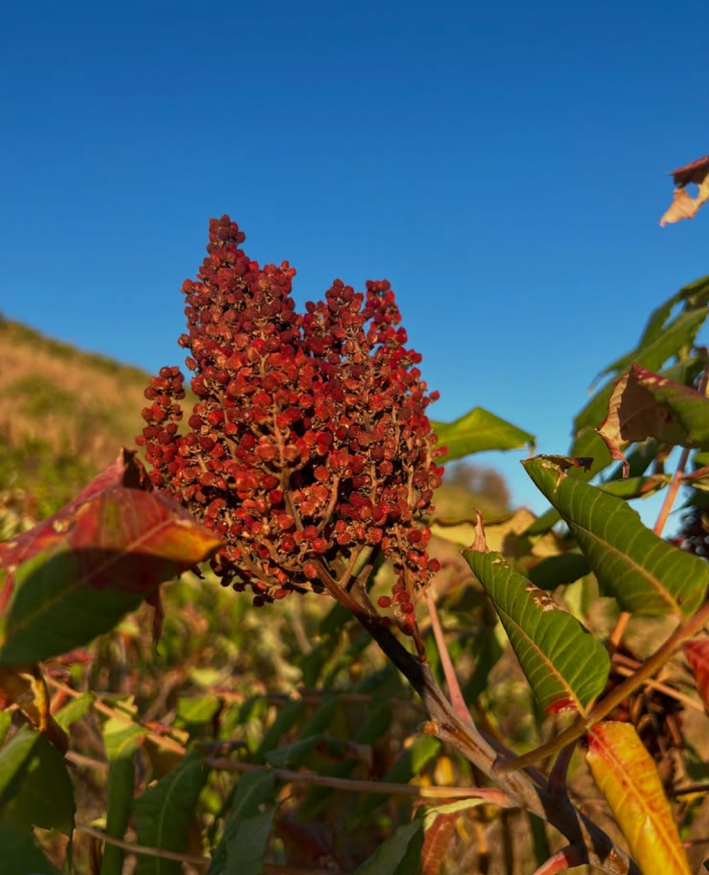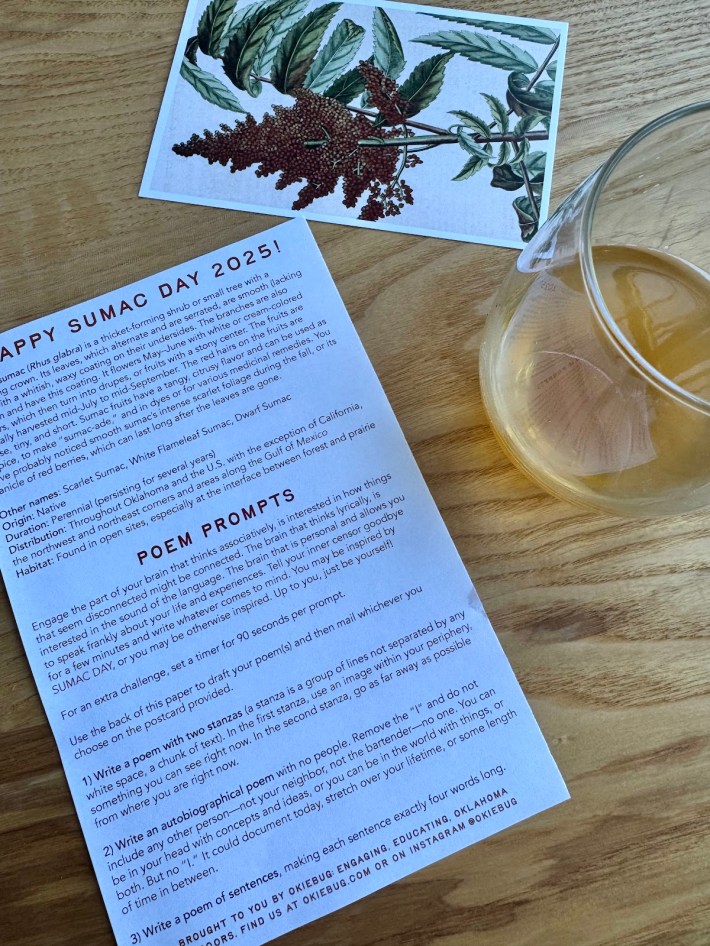Sumac Day
Heirloom Rustic Ales
August 22, 2025
It's officially sumac season in Tulsa, where you can't travel more than a mile down Highway 51 without seeing hundreds of wild sumac shrubs dotting the landscape. Thanks to heavy rains at the start of the summer, Winged Sumac in particular has been prolific this year, and ecologist and Heirloom Rustic Ales brew-master Jake Miller knew just what to do with it.
In previous years, the answer was simple: brew beer. Every summer over the past six, Miller and his Heirloom crew have trekked to the local grasslands to harvest a haul of Winged Sumac for their annual sumac beer release. This year, they came back from the hillsides with fingers stained cherry-red from the plant’s oils, a few chigger bites, and a 125-pound harvest of both Winged and Smooth sumac. With mother nature providing so much native bounty this year, Miller wanted to go big: why not cook with it, too?
This question informed the brief for Sumac Day, held last Friday at Heirloom, where Sumac received center stage billing across food and drink. Miller presented a challenge to his colleagues at Coffee at Heirloom, Dante’s Woodfire Pizza, and Old Dog: create something featuring sumac that can introduce Tulsans to this native treasure, and help them appreciate the zingy, citrusy flavor of the resource in all its glory.
Sumac is a staple spice in Mediterranean and Middle Eastern cooking, where cooks often reach for the brightness of its lemon-forward flavors to balance the smoke and richness of grilled meats, creamy sauces, and hummus. Sumac was used for years as a tang agent before lemons were widely available, and has long been used by Indigenous communities to make teas, medicinal beverages, and even sumac lemonade. Yet despite sumac’s ubiquity as a native Oklahoma plant, it’s fairly under-utilized in local cooking, perhaps suffering by association with poison sumac. (Notably, poison sumac isn’t even native to Oklahoma.)
Miller—a lifelong forager who’s become a little obsessed with sumac over the years—thinks the overlook is a shame, and wanted to help Tulsans get better acquainted with the bounty in our own backyard. “It’s weird how a plant can take over your entire perspective,” he admits.

On Sumac Day, Tulsans who came out to the bustling Heirloom taproom were subject to a Miller-style perspective shift, and an exploration of questions like What happens to well-understood flavors when we introduce a new one? What could happen if more of us did so more often? What gifts are within our reach, and how might we use them differently? The result, it seems, is surprising flavors, new possibilities, and a chance to enjoy both in community.
Heirloom’s contribution to Sumac Day was their annual Wiseblood beer. When added to their blonde kolsch, fermented sumac gives the beer a rose-like tint and a refreshing hint of lemon. Miller described it as a “lowkey field beer with a light tartness.” I’d liken it to an elevated, lemony lawnmower beer with better flavor, similar to a shandy—perfect to enjoy after an afternoon spent working the garden.
Syrups are standard practice for Coffee at Heirloom, and Tyler Villarele opted to boil the sumac into a deep pink syrup for the occasion, adding it into a Sumac Espresso Tonic made with washed Ethiopian beans. The syrup’s tart cherry flavor played nicely with the subtle citrus notes of the coffee beans, leaving a slight whiff of cobbler on the nose. I’m not usually into espresso tonics myself, but after this one, color me curious, if not converted.
Dante’s offering was a Sumac Pie, featuring ricotta and mozz, sumac chicken, and sliced onion, finished with lemon zest, basil, and sunflower seeds. Pizza slinger Beau Ballard used a sumac glaze to marinate the chicken and add brightness, and then finished each pie with an extra drizzle over the top. The richness of the cheese rendered the sumac flavors really subtle in this one, and you might’ve missed them altogether if not for the glaze. Adding sunflower seeds and lemon zest tied the pie together nicely with unexpected taste and texture—surprising, summery, and perfectly fired.
In a bummer turn of events, the health department allegedly came down on Old Dog last week over a permitting technicality, rendering them unable to participate in the event (this is why we can’t have nice things). But it’s rumored that Old Dog has developed a sumac laab feature that’ll be available to order once service is back up and running.
The Sumac Day study was further enhanced by a poetry prompt crafted by Okiebug, designed to help patrons to drop further into the plant’s sensory experience and harvest some words of their own. Postcards accompanied the poetry prompts so folks could share their reflections with a loved one—a sort of literary dispatch of notes from the field.

That field is ripe with opportunities to partner with and celebrate Oklahoma’s natural bounty. By Miller's estimate, fewer than 10 national breweries currently brew with sumac, and Heirloom was the first in Oklahoma to brew with the foraged plant. As a conservationist, Miller is committed to foraging in brewing. He's logged many chigger-ridden PTO days with his wife and co-owner Melissa French and the Heirloom team out in the fields around Tulsa, foraging for native plants like sumac and dandelions that eventually make their way into the fermentation process. Miller sees it as a way to honor Oklahoma’s local ecology and the nuance of native terroir.
“It kills me that people aren’t talking about sumac, or using it much,” he said, “because it’s everywhere. It’s an underused resource, with a really cool flavor component, and we should be using and enjoying what we have around us. You see people traveling to enjoy the Sequoias in California, but there’s nothing like that in Oklahoma.”
If Sumac Day returns in future years, and if more of the region can come to understand the versatility of its harvest, perhaps we’ll see something like a sumac pilgrimage start to take shape. Until then, Tulsans can pick up a six-pack of Wiseblood at Heirloom to taste the flavor in all its glory, or head to highway roadsides to pick their own.






